2008 INFINITI FX35 air condition
[x] Cancel search: air conditionPage 3215 of 3924
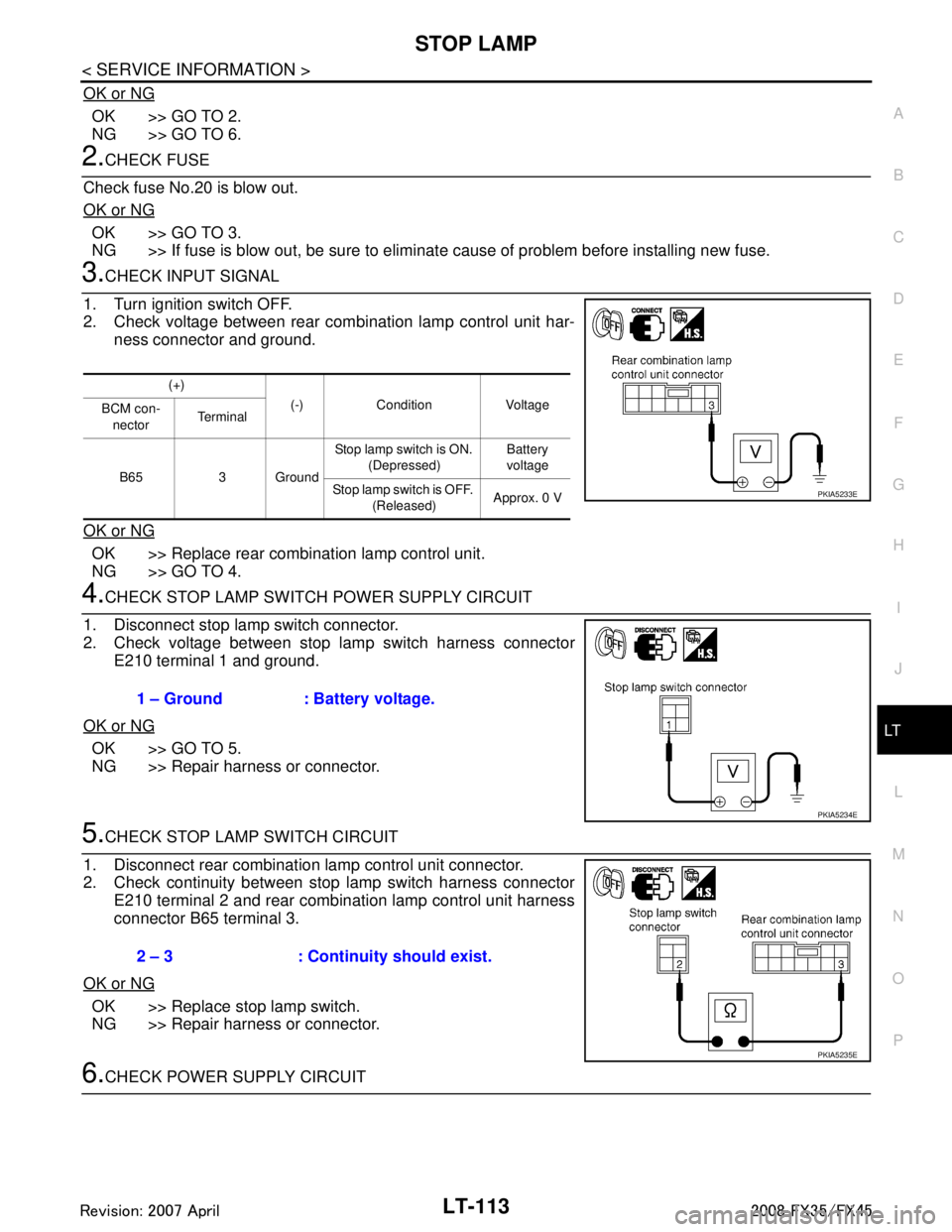
STOP LAMPLT-113
< SERVICE INFORMATION >
C
DE
F
G H
I
J
L
M A
B
LT
N
O P
OK or NG
OK >> GO TO 2.
NG >> GO TO 6.
2.CHECK FUSE
Check fuse No.20 is blow out.
OK or NG
OK >> GO TO 3.
NG >> If fuse is blow out, be sure to eliminate cause of problem before installing new fuse.
3.CHECK INPUT SIGNAL
1. Turn ignition switch OFF.
2. Check voltage between rear combination lamp control unit har- ness connector and ground.
OK or NG
OK >> Replace rear combination lamp control unit.
NG >> GO TO 4.
4.CHECK STOP LAMP SWIT CH POWER SUPPLY CIRCUIT
1. Disconnect stop lamp switch connector.
2. Check voltage between stop lamp switch harness connector E210 terminal 1 and ground.
OK or NG
OK >> GO TO 5.
NG >> Repair harness or connector.
5.CHECK STOP LAMP SWITCH CIRCUIT
1. Disconnect rear combination lamp control unit connector.
2. Check continuity between stop lamp switch harness connector E210 terminal 2 and rear combi nation lamp control unit harness
connector B65 terminal 3.
OK or NG
OK >> Replace stop lamp switch.
NG >> Repair harness or connector.
6.CHECK POWER SUPPLY CIRCUIT
(+) (-) Condition Voltage
BCM con-
nector Te r m i n a l
B65 3 Ground Stop lamp switch is ON.
(Depressed) Battery
voltage
Stop lamp switch is OFF. (Released) Approx. 0 V
PKIA5233E
1 – Ground : Battery voltage.
PKIA5234E
2 – 3 : Continuity should exist.
PKIA5235E
3AA93ABC3ACD3AC03ACA3AC03AC63AC53A913A773A893A873A873A8E3A773A983AC73AC93AC03AC3
3A893A873A873A8F3A773A9D3AAF3A8A3A8C3A863A9D3AAF3A8B3A8C
Page 3230 of 3924
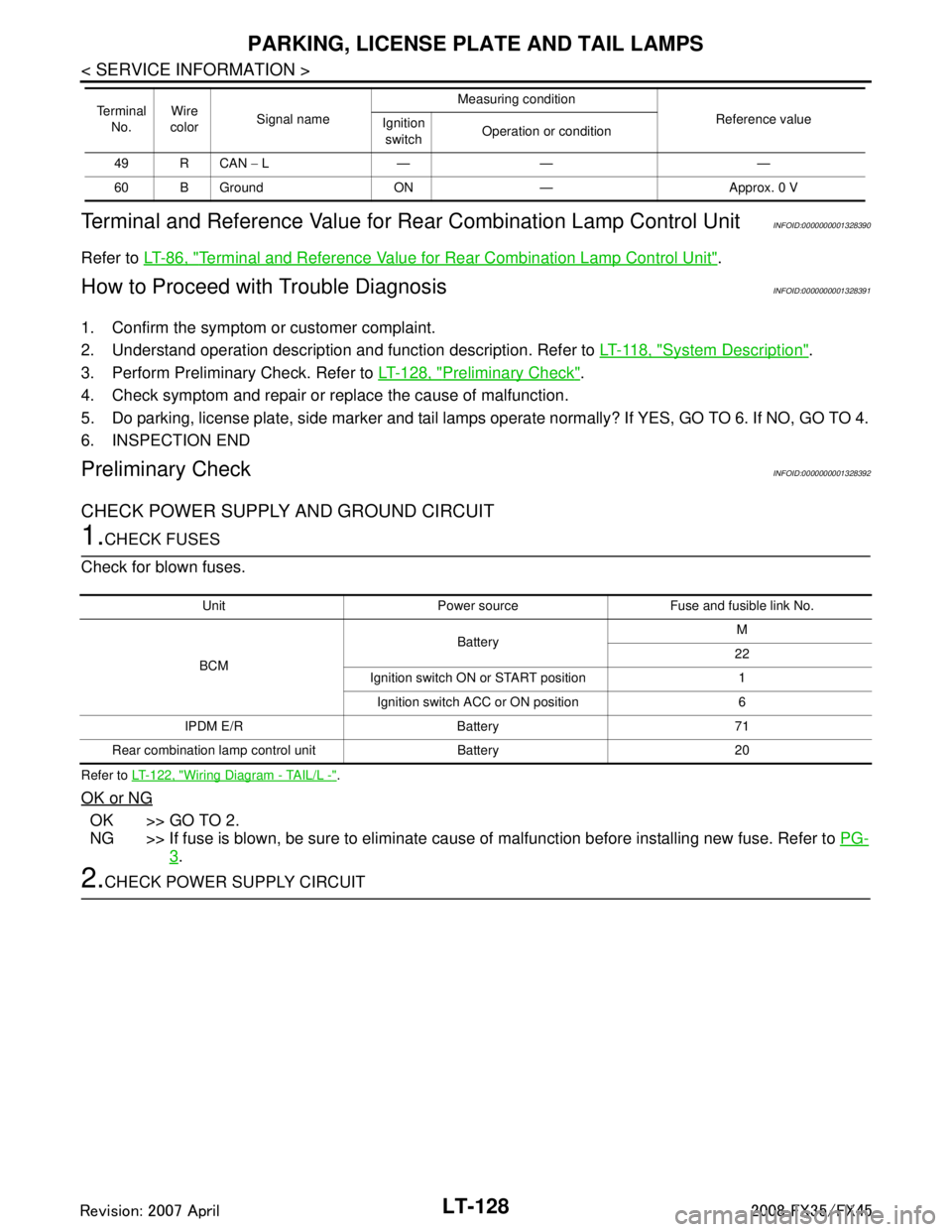
LT-128
< SERVICE INFORMATION >
PARKING, LICENSE PLATE AND TAIL LAMPS
Terminal and Reference Value for Re ar Combination Lamp Control Unit
INFOID:0000000001328390
Refer to LT-86, "Terminal and Reference Value for Rear Combination Lamp Control Unit".
How to Proceed with Trouble DiagnosisINFOID:0000000001328391
1. Confirm the symptom or customer complaint.
2. Understand operation description and function description. Refer to LT-118, "
System Description".
3. Perform Preliminary Check. Refer to LT-128, "
Preliminary Check".
4. Check symptom and repair or r eplace the cause of malfunction.
5. Do parking, license plate, side marker and tail lamps operate normally? If YES, GO TO 6. If NO, GO TO 4.
6. INSPECTION END
Preliminary CheckINFOID:0000000001328392
CHECK POWER SUPPLY AND GROUND CIRCUIT
1.CHECK FUSES
Check for blown fuses.
Refer to LT- 1 2 2 , "Wiring Diagram - TAIL/L -".
OK or NG
OK >> GO TO 2.
NG >> If fuse is blown, be sure to eliminate caus e of malfunction before installing new fuse. Refer to PG-
3.
2.CHECK POWER SUPPLY CIRCUIT
49 R CAN − L— — —
60 B Ground ON — Approx. 0 V
Te r m i n a l
No. Wire
color Signal name Measuring condition
Reference value
Ignition
switch Operation or condition
Unit Power source Fuse and fusible link No.
BCM Battery
M
22
Ignition switch ON or START position 1 Ignition switch ACC or ON position 6
IPDM E/R Battery 71
Rear combination lamp control unit Battery 20
3AA93ABC3ACD3AC03ACA3AC03AC63AC53A913A773A893A873A873A8E3A773A983AC73AC93AC03AC3
3A893A873A873A8F3A773A9D3AAF3A8A3A8C3A863A9D3AAF3A8B3A8C
Page 3235 of 3924
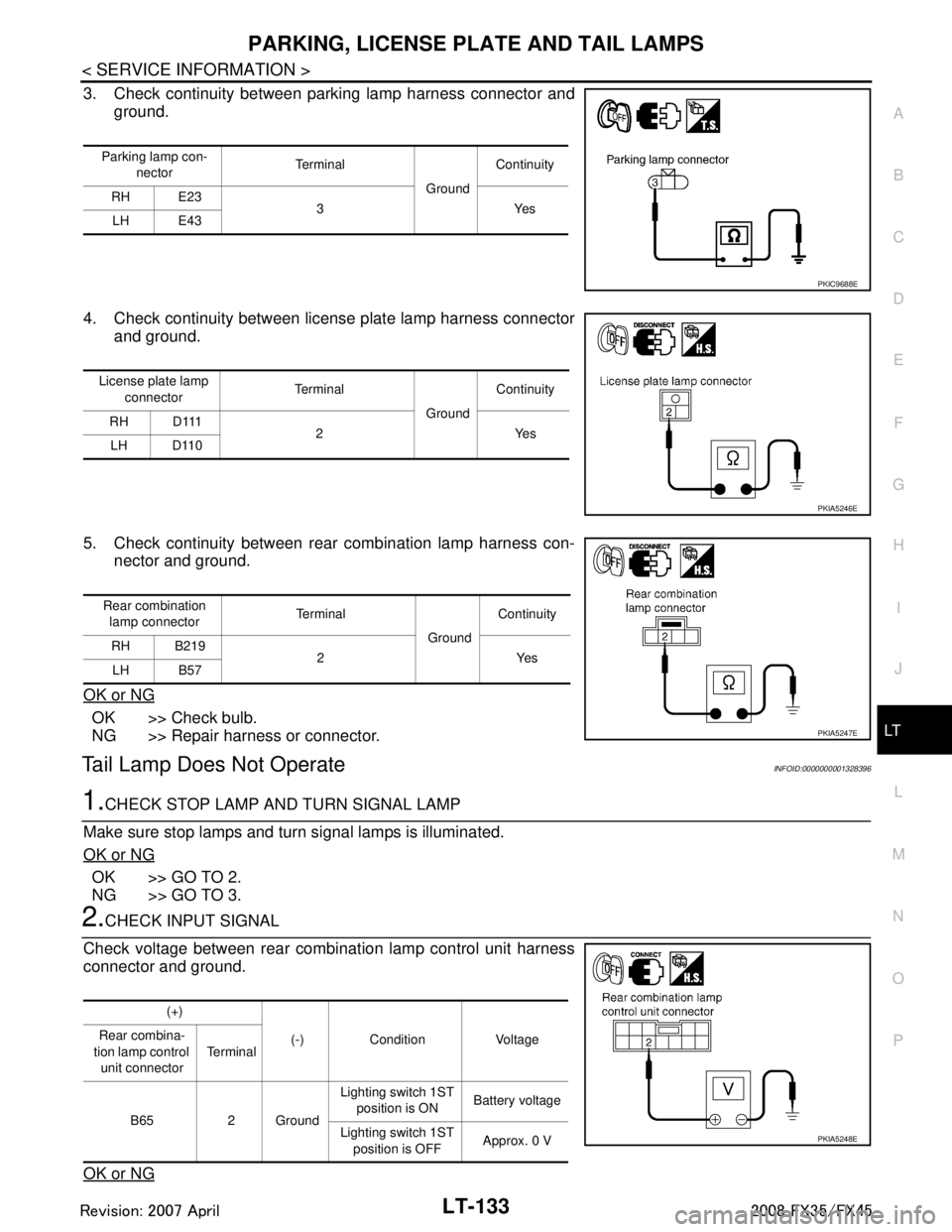
PARKING, LICENSE PLATE AND TAIL LAMPS
LT-133
< SERVICE INFORMATION >
C
D E
F
G H
I
J
L
M A
B
LT
N
O P
3. Check continuity between parking lamp harness connector and ground.
4. Check continuity between license plate lamp harness connector and ground.
5. Check continuity between rear combination lamp harness con- nector and ground.
OK or NG
OK >> Check bulb.
NG >> Repair harness or connector.
Tail Lamp Does Not OperateINFOID:0000000001328396
1.CHECK STOP LAMP AND TURN SIGNAL LAMP
Make sure stop lamps and turn signal lamps is illuminated.
OK or NG
OK >> GO TO 2.
NG >> GO TO 3.
2.CHECK INPUT SIGNAL
Check voltage between rear combination lamp control unit harness
connector and ground.
OK or NG
Parking lamp con- nector Te r m i n a l
GroundContinuity
RH E23 3Yes
LH E43
PKIC9688E
License plate lamp
connector Te r m i n a l
GroundContinuity
RH D111 2Yes
LH D110
PKIA5246E
Rear combination
lamp connector Te r m i n a l
GroundContinuity
RH B219 2Yes
LH B57
PKIA5247E
(+)
(-) Condition Voltage
Rear combina-
tion lamp control unit connector Te r m i n a l
B65 2 Ground Lighting switch 1ST
position is ON Battery voltage
Lighting switch 1ST position is OFF Approx. 0 V
PKIA5248E
3AA93ABC3ACD3AC03ACA3AC03AC63AC53A913A773A893A873A873A8E3A773A983AC73AC93AC03AC3
3A893A873A873A8F3A773A9D3AAF3A8A3A8C3A863A9D3AAF3A8B3A8C
Page 3256 of 3924
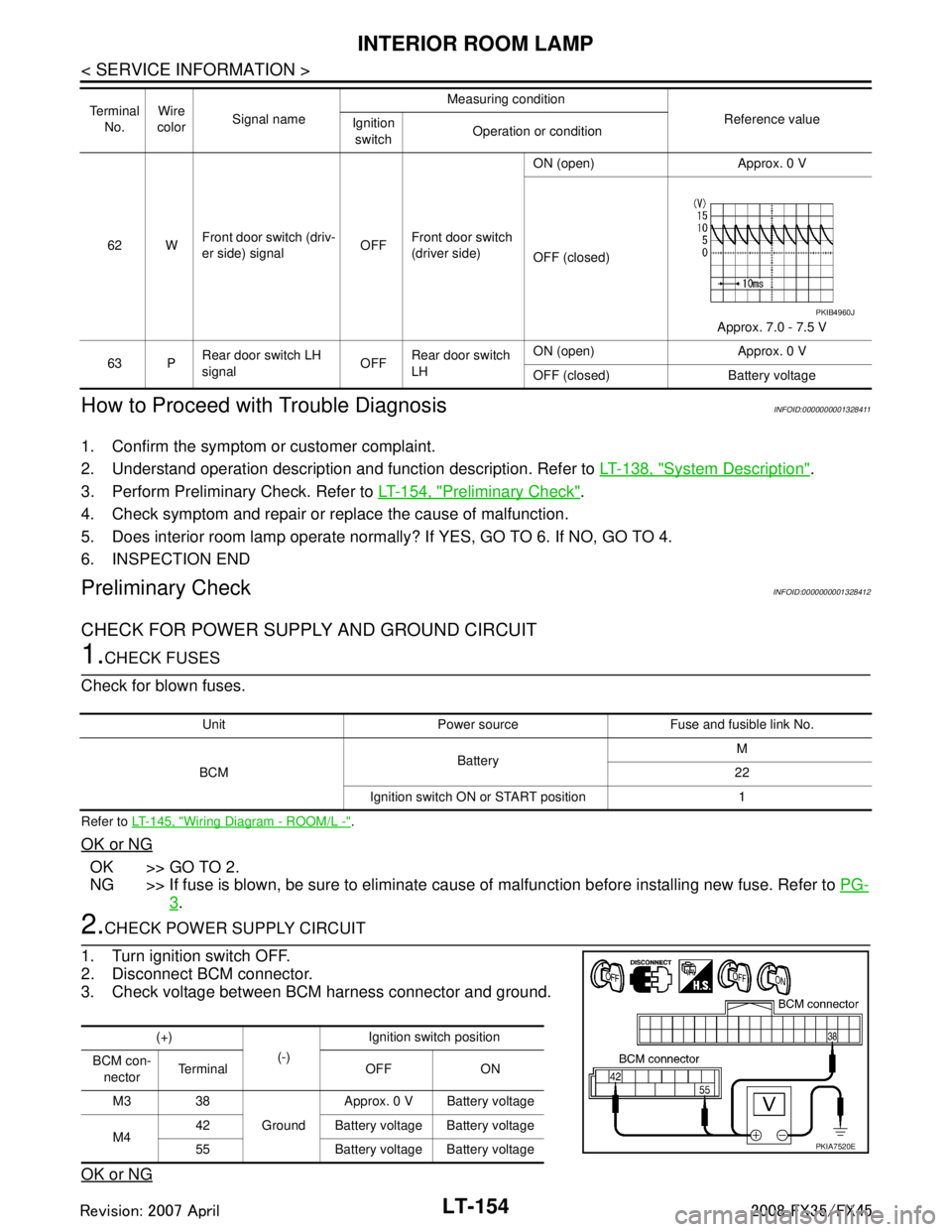
LT-154
< SERVICE INFORMATION >
INTERIOR ROOM LAMP
How to Proceed with Trouble Diagnosis
INFOID:0000000001328411
1. Confirm the symptom or customer complaint.
2. Understand operation description and function description. Refer to LT-138, "
System Description".
3. Perform Preliminary Check. Refer to LT-154, "
Preliminary Check".
4. Check symptom and repair or r eplace the cause of malfunction.
5. Does interior room lamp operate normally ? If YES, GO TO 6. If NO, GO TO 4.
6. INSPECTION END
Preliminary CheckINFOID:0000000001328412
CHECK FOR POWER SUPPLY AND GROUND CIRCUIT
1.CHECK FUSES
Check for blown fuses.
Refer to LT- 1 4 5 , "Wiring Diagram - ROOM/L -".
OK or NG
OK >> GO TO 2.
NG >> If fuse is blown, be sure to eliminate caus e of malfunction before installing new fuse. Refer to PG-
3.
2.CHECK POWER SUPPLY CIRCUIT
1. Turn ignition switch OFF.
2. Disconnect BCM connector.
3. Check voltage between BCM harness connector and ground.
OK or NG
62 W Front door switch (driv-
er side) signal
OFFFront door switch
(driver side) ON (open) Approx. 0 V
OFF (closed)
Approx. 7.0 - 7.5 V
63 P Rear door switch LH
signal OFF
Rear door switch
LH ON (open) Approx. 0 V
OFF (closed) Ba
ttery voltage
Te r m i n a l
No. Wire
color Signal name Measuring condition
Reference value
Ignition
switch Operation or condition
PKIB4960J
Unit Power source Fuse and fusible link No.
BCM Battery M
22
Ignition switch ON or START position 1
(+) (-)Ignition switch position
BCM con- nector Te r m i n a l O F F O N
M3 38 GroundApprox. 0 V Battery voltage
M4 42 Battery voltage Battery voltage
55 Battery voltage Battery voltage
PKIA7520E
3AA93ABC3ACD3AC03ACA3AC03AC63AC53A913A773A893A873A873A8E3A773A983AC73AC93AC03AC3
3A893A873A873A8F3A773A9D3AAF3A8A3A8C3A863A9D3AAF3A8B3A8C
Page 3260 of 3924
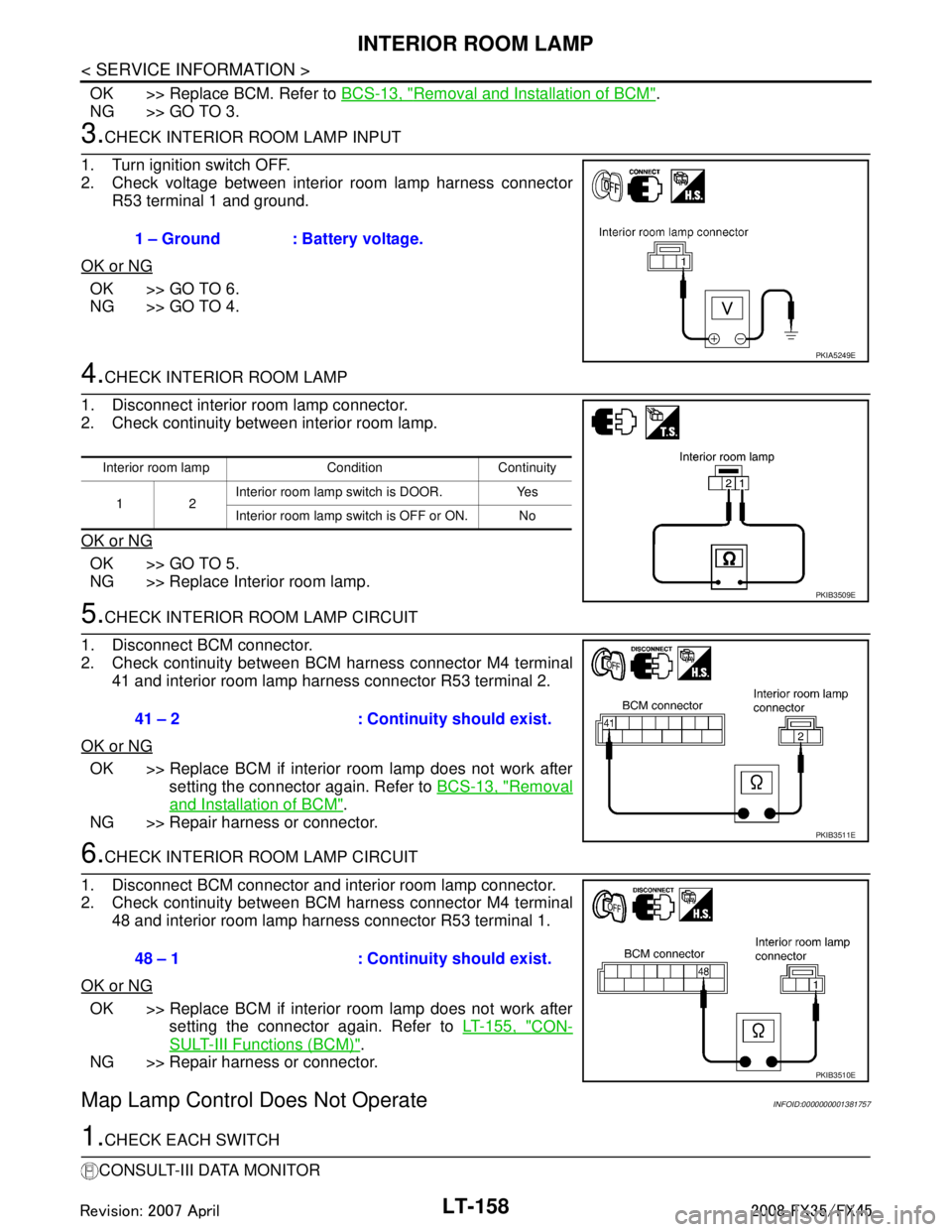
LT-158
< SERVICE INFORMATION >
INTERIOR ROOM LAMP
OK >> Replace BCM. Refer to BCS-13, "Removal and Installation of BCM".
NG >> GO TO 3.
3.CHECK INTERIOR ROOM LAMP INPUT
1. Turn ignition switch OFF.
2. Check voltage between interior room lamp harness connector R53 terminal 1 and ground.
OK or NG
OK >> GO TO 6.
NG >> GO TO 4.
4.CHECK INTERIOR ROOM LAMP
1. Disconnect interior room lamp connector.
2. Check continuity between interior room lamp.
OK or NG
OK >> GO TO 5.
NG >> Replace Interior room lamp.
5.CHECK INTERIOR ROOM LAMP CIRCUIT
1. Disconnect BCM connector.
2. Check continuity between BCM harness connector M4 terminal 41 and interior room lamp harness connector R53 terminal 2.
OK or NG
OK >> Replace BCM if interior room lamp does not work after setting the connector again. Refer to BCS-13, "
Removal
and Installation of BCM".
NG >> Repair harness or connector.
6.CHECK INTERIOR ROOM LAMP CIRCUIT
1. Disconnect BCM connector and interior room lamp connector.
2. Check continuity between BCM harness connector M4 terminal 48 and interior room lamp harness connector R53 terminal 1.
OK or NG
OK >> Replace BCM if interior room lamp does not work after setting the connector again. Refer to LT-155, "
CON-
SULT-III Functions (BCM)".
NG >> Repair harness or connector.
Map Lamp Control Does Not OperateINFOID:0000000001381757
1.CHECK EACH SWITCH
CONSULT-III DATA MONITOR 1 – Ground : Battery voltage.
PKIA5249E
Interior room lamp Condition Continuity
12 Interior room lamp switch is DOOR. Yes
Interior room lamp switch is OFF or ON. No
PKIB3509E
41 – 2 : Continuity should exist.
PKIB3511E
48 – 1 : Continuity should exist.
PKIB3510E
3AA93ABC3ACD3AC03ACA3AC03AC63AC53A913A773A893A873A873A8E3A773A983AC73AC93AC03AC3
3A893A873A873A8F3A773A9D3AAF3A8A3A8C3A863A9D3AAF3A8B3A8C
Page 3261 of 3924
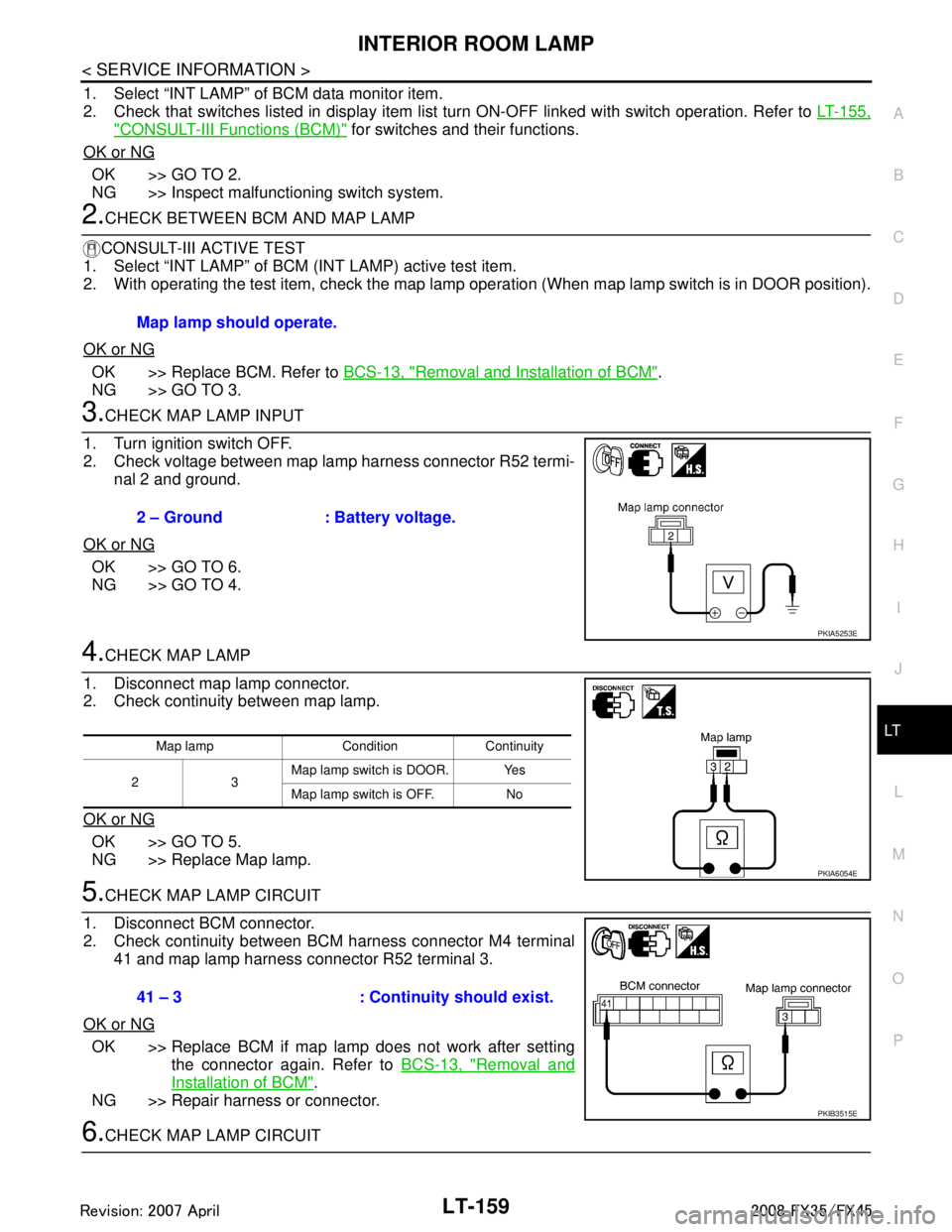
INTERIOR ROOM LAMPLT-159
< SERVICE INFORMATION >
C
DE
F
G H
I
J
L
M A
B
LT
N
O P
1. Select “INT LAMP” of BCM data monitor item.
2. Check that switches listed in display item list turn ON-OFF linked with switch operation. Refer to LT-155,
"CONSULT-III Functions (BCM)" for switches and their functions.
OK or NG
OK >> GO TO 2.
NG >> Inspect malfunctioning switch system.
2.CHECK BETWEEN BC M AND MAP LAMP
CONSULT-III ACTIVE TEST
1. Select “INT LAMP” of BCM (INT LAMP) active test item.
2. With operating the test item, check the map lamp oper ation (When map lamp switch is in DOOR position).
OK or NG
OK >> Replace BCM. Refer to BCS-13, "Removal and Installation of BCM".
NG >> GO TO 3.
3.CHECK MAP LAMP INPUT
1. Turn ignition switch OFF.
2. Check voltage between map lamp harness connector R52 termi- nal 2 and ground.
OK or NG
OK >> GO TO 6.
NG >> GO TO 4.
4.CHECK MAP LAMP
1. Disconnect map lamp connector.
2. Check continuity between map lamp.
OK or NG
OK >> GO TO 5.
NG >> Replace Map lamp.
5.CHECK MAP LAMP CIRCUIT
1. Disconnect BCM connector.
2. Check continuity between BCM harness connector M4 terminal 41 and map lamp harness connector R52 terminal 3.
OK or NG
OK >> Replace BCM if map lamp does not work after setting the connector again. Refer to BCS-13, "
Removal and
Installation of BCM".
NG >> Repair harness or connector.
6.CHECK MAP LAMP CIRCUIT Map lamp should operate.
2 – Ground : Battery voltage.
PKIA5253E
Map lamp Condition Continuity
23 Map lamp switch is DOOR. Yes
Map lamp switch is OFF. No
PKIA6054E
41 – 3 : Continui
ty should exist.
PKIB3515E
3AA93ABC3ACD3AC03ACA3AC03AC63AC53A913A773A893A873A873A8E3A773A983AC73AC93AC03AC3
3A893A873A873A8F3A773A9D3AAF3A8A3A8C3A863A9D3AAF3A8B3A8C
Page 3320 of 3924
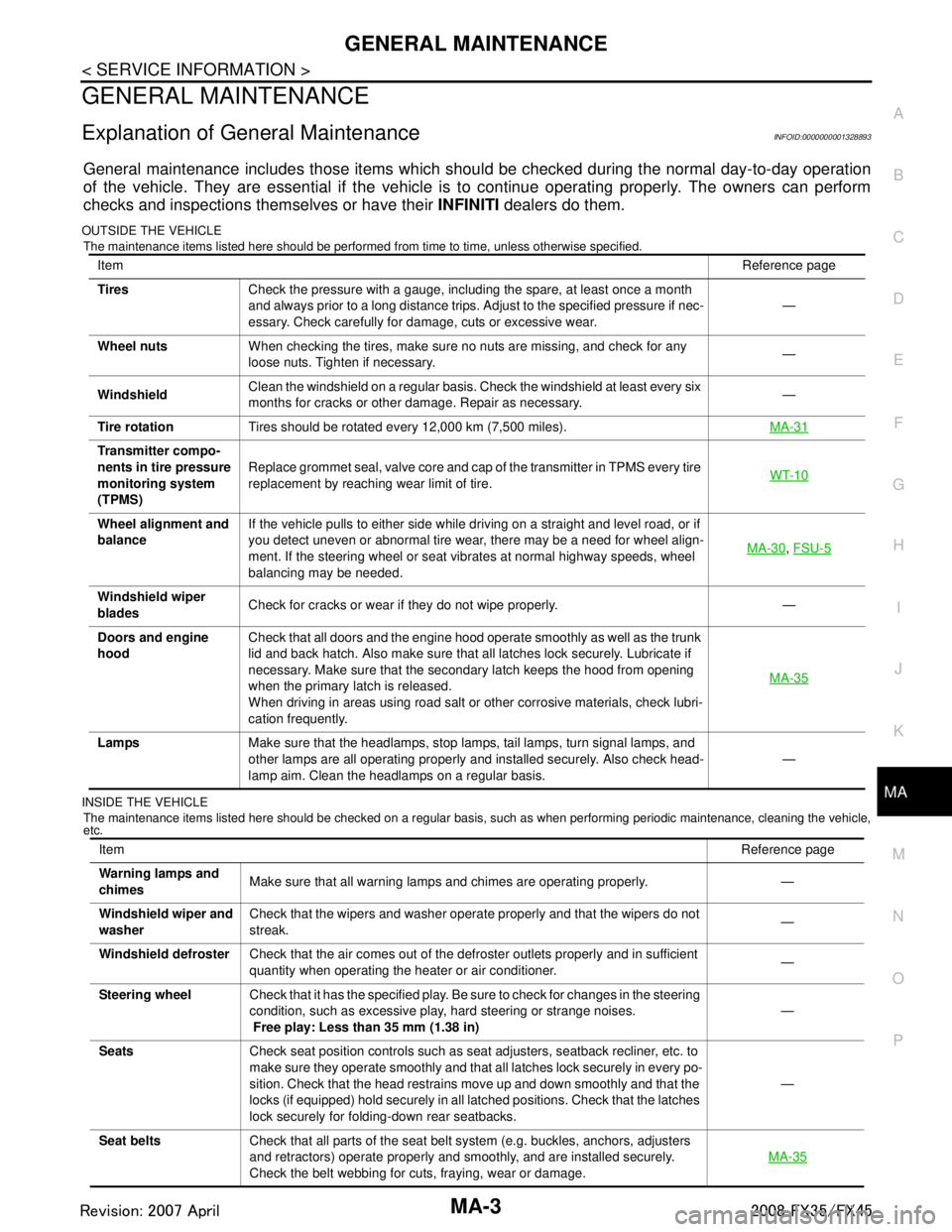
GENERAL MAINTENANCEMA-3
< SERVICE INFORMATION >
C
DE
F
G H
I
J
K
M A
B
MA
N
O P
GENERAL MAINTENANCE
Explanation of Gene ral MaintenanceINFOID:0000000001328893
General maintenance includes those items which shoul d be checked during the normal day-to-day operation
of the vehicle. They are essential if the vehicle is to continue operating properly. The owners can perform
checks and inspections themselves or have their INFINITI dealers do them.
OUTSIDE THE VEHICLE
The maintenance items listed here should be performed from time to time, unless otherwise specified.
INSIDE THE VEHICLE The maintenance items listed here should be checked on a regular basis, such as when performing periodic maintenance, cleaning the vehicle,
etc.
Item Reference page
Tires Check the pressure with a gauge, including the spare, at least once a month
and always prior to a long distance trips. Adjust to the specified pressure if nec-
essary. Check carefully for damage, cuts or excessive wear. —
Wheel nuts When checking the tires, make sure no nuts are missing, and check for any
loose nuts. Tighten if necessary. —
Windshield Clean the windshield on a regular basis. Check the windshield at least every six
months for cracks or other damage. Repair as necessary. —
Tire rotation Tires should be rotated every 12,000 km (7,500 miles). MA-31
Transmitter compo-
nents in tire pressure
monitoring system
(TPMS)Replace grommet seal, valve core and cap of the transmitter in TPMS every tire
replacement by reaching wear limit of tire.
WT-10
Wheel alignment and
balanceIf the vehicle pulls to either side while driving on a straight and level road, or if
you detect uneven or abnormal tire wear, there may be a need for wheel align-
ment. If the steering wheel or seat vibrates at normal highway speeds, wheel
balancing may be needed. MA-30
,
FSU-5
Windshield wiper
blades Check for cracks or wear if they do not wipe properly. —
Doors and engine
hood Check that all doors and the engine hood operate smoothly as well as the trunk
lid and back hatch. Also make sure that all latches lock securely. Lubricate if
necessary. Make sure that the secondary latch keeps the hood from opening
when the primary latch is released.
When driving in areas using road salt or other corrosive materials, check lubri-
cation frequently. MA-35
Lamps
Make sure that the headlamps, stop lamps, tail lamps, turn signal lamps, and
other lamps are all operating properly and installed securely. Also check head-
lamp aim. Clean the headlamps on a regular basis. —
Item
Reference page
Warning lamps and
chimes Make sure that all warning lamps and chimes are operating properly. —
Windshield wiper and
washer Check that the wipers and washer operate properly and that the wipers do not
streak.
—
Windshield defroster Check that the air comes out of the defroster outlets properly and in sufficient
quantity when operating the heater or air conditioner. —
Steering wheel Check that it has the specified play. Be sure to check for changes in the steering
condition, such as excessive play, hard steering or strange noises.
Free play: Less than 35 mm (1.38 in) —
Seats Check seat position controls such as seat adjusters, seatback recliner, etc. to
make sure they operate smoothly and that all latches lock securely in every po-
sition. Check that the head restrains move up and down smoothly and that the
locks (if equipped) hold securely in all latched positions. Check that the latches
lock securely for folding-down rear seatbacks. —
Seat belts Check that all parts of the seat belt system (e.g. buckles, anchors, adjusters
and retractors) operate properly and smoothly, and are installed securely.
Check the belt webbing for cuts, fraying, wear or damage. MA-35
3AA93ABC3ACD3AC03ACA3AC03AC63AC53A913A773A893A873A873A8E3A773A983AC73AC93AC03AC3
3A893A873A873A8F3A773A9D3AAF3A8A3A8C3A863A9D3AAF3A8B3A8C
Page 3321 of 3924
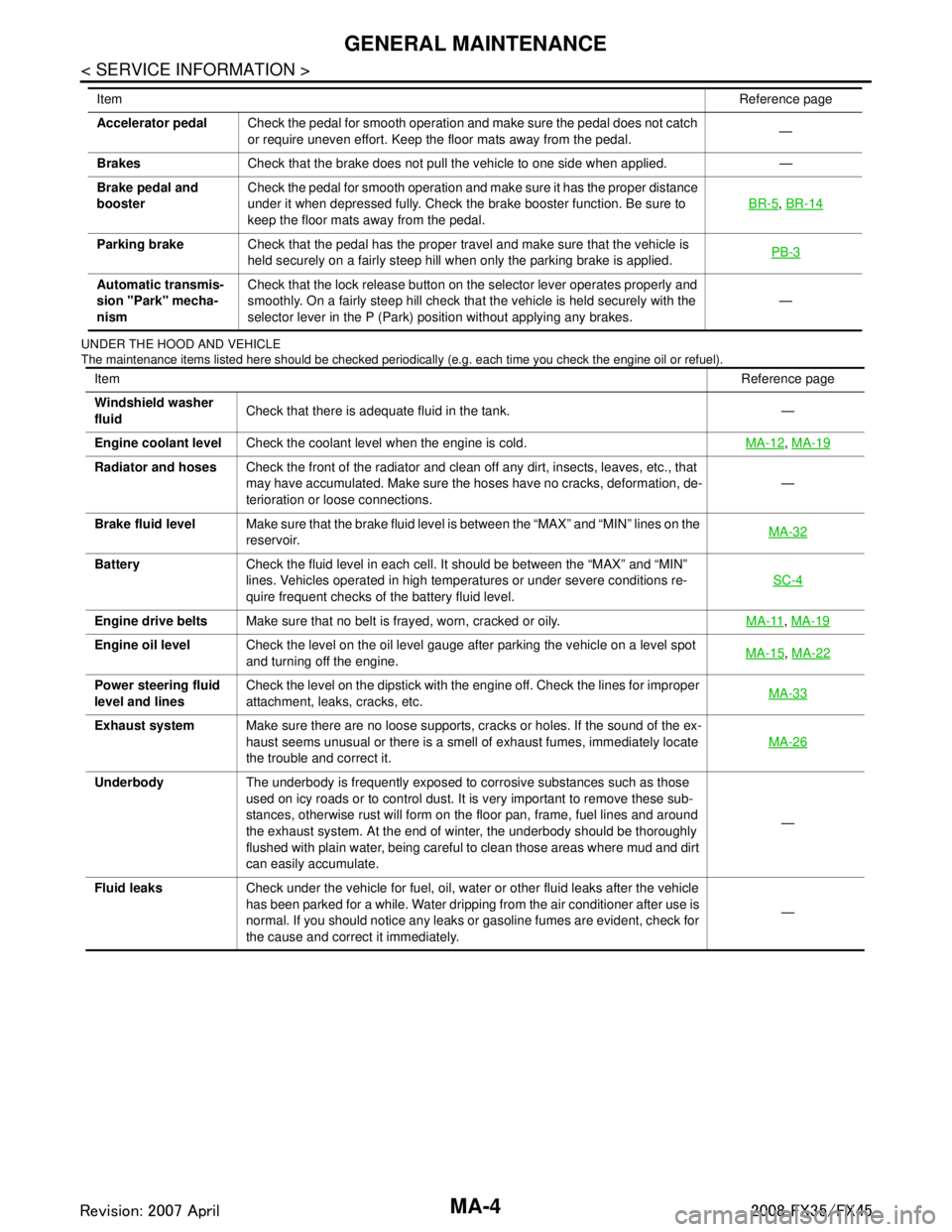
MA-4
< SERVICE INFORMATION >
GENERAL MAINTENANCE
UNDER THE HOOD AND VEHICLE
The maintenance items listed here should be checked periodically (e.g. each time you check the engine oil or refuel).
Accelerator pedalCheck the pedal for smooth operation and make sure the pedal does not catch
or require uneven effort. Keep the floor mats away from the pedal. —
Brakes Check that the brake does not pull the vehicle to one side when applied. —
Brake pedal and
booster Check the pedal for smooth operation and make sure it has the proper distance
under it when depressed fully. Check the brake booster function. Be sure to
keep the floor mats away from the pedal. BR-5
,
BR-14
Parking brake Check that the pedal has the proper travel and make sure that the vehicle is
held securely on a fairly steep hill when only the parking brake is applied. PB-3
Automatic transmis-
sion "Park" mecha-
nismCheck that the lock release button on the selector lever operates properly and
smoothly. On a fairly steep hill check that the vehicle is held securely with the
selector lever in the P (Park) position without applying any brakes.
—
Item
Reference page
Item Reference page
Windshield washer
fluid Check that there is adequate fluid in the tank. —
Engine coolant level Check the coolant level when the engine is cold. MA-12
, MA-19
Radiator and hoses Check the front of the radiator and clean off any dirt, insects, leaves, etc., that
may have accumulated. Make sure the hoses have no cracks, deformation, de-
terioration or loose connections. —
Brake fluid level Make sure that the brake fluid level is between the “MAX” and “MIN” lines on the
reservoir. MA-32
Battery Check the fluid level in each cell. It should be between the “MAX” and “MIN”
lines. Vehicles operated in high temperatures or under severe conditions re-
quire frequent checks of the battery fluid level. SC-4
Engine drive belts
Make sure that no belt is frayed, worn, cracked or oily. MA-11, MA-19
Engine oil level Check the level on the oil level gauge after parking the vehicle on a level spot
and turning off the engine. MA-15,
MA-22
Power steering fluid
level and lines Check the level on the dipstick with the engine off. Check the lines for improper
attachment, leaks, cracks, etc.
MA-33
Exhaust system
Make sure there are no loose supports, cracks or holes. If the sound of the ex-
haust seems unusual or there is a smell of exhaust fumes, immediately locate
the trouble and correct it. MA-26
Underbody
The underbody is frequently exposed to corrosive substances such as those
used on icy roads or to control dust. It is very important to remove these sub-
stances, otherwise rust will form on the floor pan, frame, fuel lines and around
the exhaust system. At the end of winter, the underbody should be thoroughly
flushed with plain water, being careful to clean those areas where mud and dirt
can easily accumulate. —
Fluid leaks Check under the vehicle for fuel, oil, water or other fluid leaks after the vehicle
has been parked for a while. Water dripping from the air conditioner after use is
normal. If you should notice any leaks or gasoline fumes are evident, check for
the cause and correct it immediately. —
3AA93ABC3ACD3AC03ACA3AC03AC63AC53A913A773A893A873A873A8E3A773A983AC73AC93AC03AC3
3A893A873A873A8F3A773A9D3AAF3A8A3A8C3A863A9D3AAF3A8B3A8C